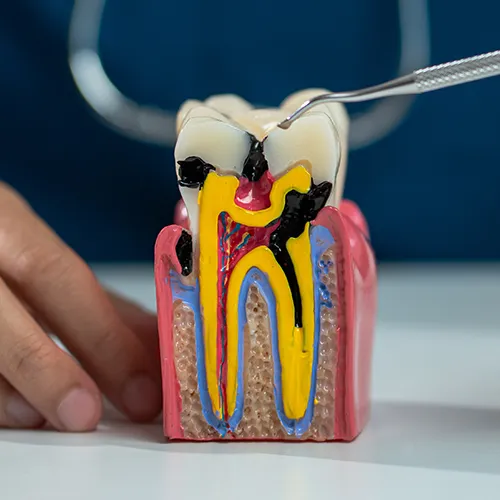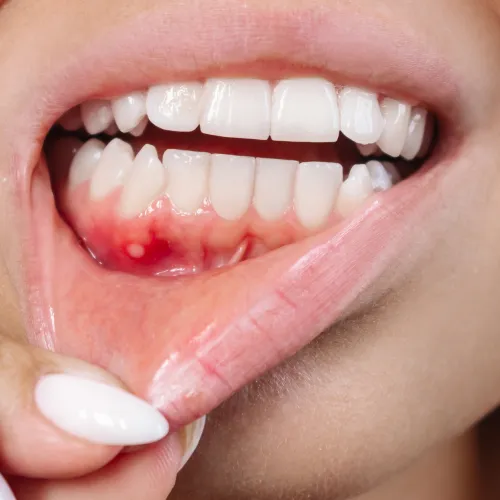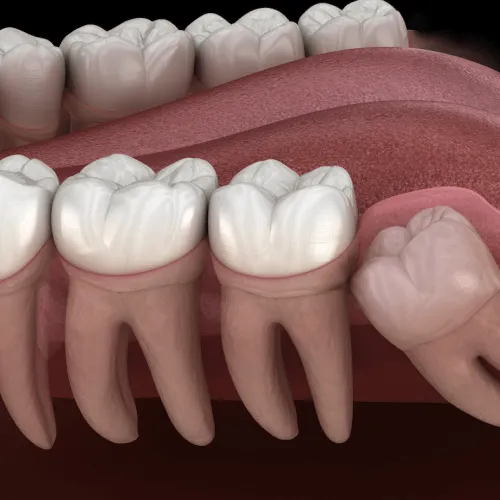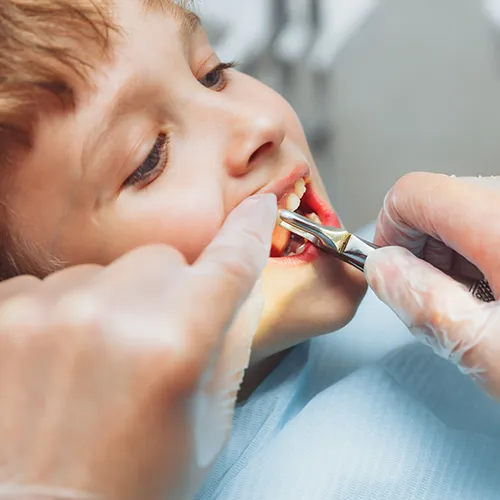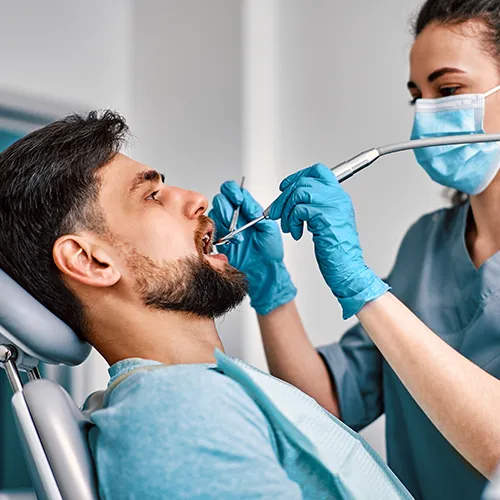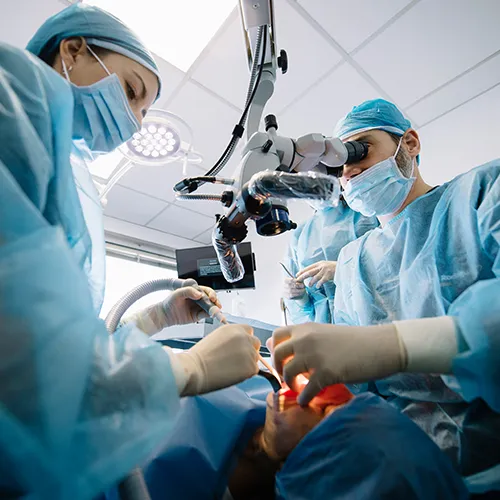Emergency Dentistry
Impacted Wisdom Teeth: When Your Smile Runs Out of Space
Sometimes, wisdom doesn’t come with age; it comes with swelling, pain, and a dental appointment you didn’t plan for. If you’ve ever been told your wisdom teeth are “impacted,” you’re not alone. Millions of people face this same dental dilemma every year. At Prestige Dental, we believe you deserve to understand what’s going on beneath the surface and what your options are if those final molars are causing trouble.
Whether you’re in pain, curious, or just preparing ahead, let’s talk about impacted wisdom teeth, what to watch for, and what to do next.
Is it really necessary to remove impacted wisdom teeth?
In many cases, yes, it is necessary to remove impacted wisdom teeth — especially if they’re causing pain, infection, or damaging nearby teeth. That said, not all impacted wisdom teeth require removal right away.
It depends on how they're positioned, whether they’re causing problems, and what your dentist sees on your X-rays. Some people live with impacted wisdom teeth for years without any major issues. Others start noticing jaw stiffness, swollen gums, or even cysts around the tooth without realizing the root cause.
Impacted wisdom teeth are the third molars at the very back of your mouth. They often lack enough space to erupt fully, and that’s where problems begin. Because they’re partially or fully trapped beneath the gums or bone, they can push against other teeth, trap food and bacteria, and become infected. This can lead to swelling, pain, and damage to nearby structures. Sometimes the discomfort flares up randomly, while other times it becomes persistent.
Even if your impacted tooth isn’t hurting today, it might not stay that way. X-rays can reveal whether your molars are growing at an awkward angle or sitting too close to your nerves, sinus cavities, or other roots. In those cases, waiting too long can turn a simple extraction into a more complex surgery.
Wisdom tooth removal is often easier in your teens or early twenties, before the roots are fully formed and before complications have a chance to build. Think of it like preventative maintenance — it might feel optional now, but it could save you from more intense procedures down the line.
How do you know if a wisdom tooth is impacted?
The only way to know for sure is with a dental exam and X-ray, but there are some telltale signs. If you're feeling pain at the back of your jaw, noticing swelling or tenderness in the gums, or even having trouble opening your mouth wide, you might have an impacted wisdom tooth.
For many people, symptoms start subtly. You might feel a dull ache in your jaw that comes and goes. Gums in the very back might feel swollen or bleed slightly when brushing. Some people experience headaches, ear pain, or even bad breath they can’t quite explain.
Impacted wisdom teeth often stay hidden under the surface, which is why a visual exam alone won’t cut it. At Prestige Dental, we use X-rays to see the position of the tooth and how close it is to your nerves, jawbone, or sinuses. We also look for signs of pressure on nearby teeth. Sometimes, even if you’re not feeling pain, we can see bone loss or crowding starting to happen — and that’s a red flag.
There are three main types of impaction:
- Vertical impaction, where the tooth is mostly upright but stuck beneath the gum.
- Horizontal impaction, where the tooth is lying sideways and pressing into the adjacent tooth.
- Angular impaction, where the tooth is tilted at an angle, which can press into other roots or the bone.
Each type carries different risks, and some are more likely to cause discomfort or infection than others. The earlier we catch it, the better we can plan your care.
Are impacted wisdom teeth dangerous?
Yes, they can be. Impacted wisdom teeth have the potential to cause infections, tooth decay, cysts, gum disease, and even jaw damage if left untreated. While they might not seem urgent at first, ignoring them can lead to bigger problems over time.
One of the most common issues is pericoronitis, an infection of the soft tissue around a partially erupted wisdom tooth. This happens when food or bacteria gets trapped under the gum flap, creating the perfect storm for swelling, pain, and infection. If left unchecked, it can spread to the jaw or throat, making it difficult to swallow or breathe.
Another risk is crowding. Impacted wisdom teeth can shift your other teeth, especially if you’ve had braces or cosmetic work done. This pressure can undo years of orthodontic treatment or cause crookedness that affects your bite.
Then there are cysts and tumors. While rare, fluid-filled sacs can form around the impacted tooth. These cysts can erode the surrounding jawbone or roots of nearby teeth. In severe cases, surgical removal of both the tooth and affected bone becomes necessary.
Impacted teeth are also hard to clean. Because they’re tucked far back and may only be partially erupted, brushing and flossing around them is difficult. This makes them a breeding ground for plaque and bacteria, which can lead to decay in the wisdom tooth and the neighboring molars.
Bottom line: impacted wisdom teeth are unpredictable. They might not seem dangerous right now, but their silent effects — from decay to nerve pressure — can escalate. That’s why routine monitoring, or removal when needed, is the safest path forward.
When to Remove and When to Wait
Not every impacted wisdom tooth needs to come out today. In some cases, we recommend “watchful waiting” — keeping an eye on the tooth over time with regular X-rays and checkups. This is especially common if the tooth is fully encased in bone, isn’t pushing on other teeth, and isn’t causing pain or inflammation.
But for many patients, removing the tooth early prevents problems before they start. If you’re experiencing symptoms, have a tilted or horizontal tooth, or if your dentist sees damage to nearby teeth, extraction becomes the smart move.
At Prestige Dental, we walk you through the process. We explain what we’re seeing on your X-rays, discuss your symptoms, and outline the best course of action. Whether you need removal now or just monitoring, our goal is to protect your long-term oral health.
What to Expect During and After Extraction
The idea of removing a tooth might sound intimidating, but it’s a common, low-risk procedure — especially when done early. Most wisdom tooth extractions are done under local anesthesia, and we also offer sedation for patients who prefer a little extra comfort.
The recovery process varies depending on how impacted the tooth was. You might have some swelling or soreness for a few days, but this usually improves with ice packs and over-the-counter medication. We’ll give you specific instructions on how to clean the area, what to eat, and how to avoid dry socket — a temporary but painful complication if the blood clot dislodges early.
Most patients are back to normal within a week. If you’re younger and healthy, recovery is often quicker. Our team checks in with you after the procedure to make sure everything’s healing properly.
Let’s Take a Look at What’s Happening Back There
Whether your wisdom teeth are quietly causing trouble or you’re just planning ahead, it’s worth getting them checked. Impacted wisdom teeth aren’t always obvious, but their effects can build silently over time. The earlier we catch them, the more options you have — and the easier the treatment tends to be.
Schedule your visit with Prestige Dental today. We’ll take a close look, talk through your symptoms, and help you decide what makes the most sense for your health, comfort, and peace of mind.


